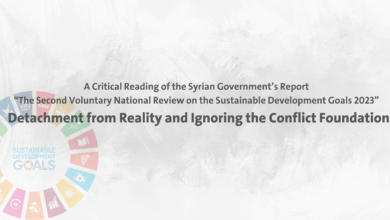Syrian Center for Policy Research 2023
On the morning of February 6th of 2023, the southern regions of Turkey and northwestern Syria were hit by a devastating earthquake unlike any other one witnessed in the region for decades. The earthquake had a catastrophic effect on Syria, a country torn by war. It shocked Syria’s marginalized and previously besieged northwest areas. The earthquake’s losses were deepened by the poor response of international powers, the negative role of internal conflict actors, and the weak institutional development and relief structures in all regions. In this context, the Syrian Center for Policy Research (SCPR) has produced a report titled “The Impact of the Earthquake in Syria, The Missing Developmental Perspective in the Shadow of Conflict” which analyzes the repercussions of the earthquake disaster and evaluates its primary direct economic, social, and institutional effects.
The Importance of the Report
An earthquake is a natural phenomenon in its first moments. Then it turns into a political, social, and developmental challenge, which depends on how the existing governance systems and the active actors respond to the effects of the disaster. The earthquake struck a country ravaged by over twelve years of war, suffering from political and social fragmentation, and whose developmental and economic foundations were devastated. The significance of this report lies in adopting a comprehensive developmental approach to analyze the disaster and to propose sustainable options to counter the effects of the earthquake, this approach places a central emphasis on achieving a just and lasting political solution, with a pivotal role for Syrian civil society in developing options towards conflict resolution and building a model for developmental transformation.
This analysis of the earthquake disaster draws on a composite framework of political economy and capabilities approaches. It adopts a participatory, interdisciplinary methodology in the research design and implementation. Within this framework, the report conducts a diagnosis of the political, economic, and social situation before the earthquake and assesses the earthquake’s impact on developmental factors while evaluating the response of active forces.
The report presents an alternative developmental approach to address the earthquake’s repercussions. This approach focuses on: investing in social solidarity and restoring respect for society inside and outside the country; shifting from the service role of civil society to an active political and developmental role in the public space; expanding the possibilities of holding political and military conflict forces accountable; developing the role of civil organizations and initiatives in establishing anti conflict, authoritarianism, and fragmentation governmental structures; adopting the social solidarity economy as one of the possible alternatives to transforming from war economies and focusing on investing material and human resources away from exploitation, militarization and depletion of the environment; linking political, social and economic actions and strengthening the developmental foundations of society so that it can influence the course of overcoming the conflict and the earthquake’s effects.
Key Findings of the Report
The earthquake led to thousands of casualties among Syrians in the affected areas. The most significant impact of the earthquake was concentrated in the northwestern regions of Syria. According to SCPR’s estimates, until the first week of March, more than 170,000 people were displaced by the earthquake. Many of those displaced by the earthquake joined already-existing shelter camps or the newly established camps to accommodate the large numbers of recent IDPs. The earthquake also affected the fragile healthcare sector due to the ongoing conflict. Thus, it could not meet the increasing demands for rescuing the injured and affected individuals in many areas. Reports that monitor communicable diseases showed a rise in cholera, acute diarrhea, and respiratory diseases in various regions.
Economically, the earthquake resulted in losses of capital stock and household wealth, amounting to 0.8 percent at the national level. Capital stock losses in Idlib reached 6.9% of the governorate total, compared to 2.1 percent in Aleppo. However, the estimates in Lattakia and Hama amounted to 6 and 3 per thousand, respectively.
The Syrian Center estimated the cost of replacing capital stock and furniture was approximately USD 2.23 billion at current prices.These losses in accumulated wealth constituted severe damage to the economy at both the national and regional levels, requiring many years to recover. The results show a decline in the national GDP in 2023 due to the earthquake by 2.2 percent. At the local level, it declined by 16.2 percent in Idlib, and 4.4 percent in Aleppo, while in Latakia and Hama, economic contraction rates were significantly lower, estimated at 5 per thousand and 3 per thousand, respectively. Overall, GDP losses are estimated at USD 3.62 billion. Added to losses in capital stock and household furniture and equipment, the total direct economic losses reached USD 5.85 billion. The direct losses of the earthquake constitute about 33 percent of GDP in 2022, indicating the significant relative impact of the earthquake and considering the catastrophic state of the economy due to twelve years of conflict.
The above situation represents additional deterioration in real household income rates and threatens further economic contraction. The results indicate increased abject poverty rates due to the earthquake by about 10.5, 3.8, 0.4, and 0.1 percentage points in Idlib, Aleppo, Hama, and Lattakia, respectively. In addition, the gap between the average spending of poor households and the overall poverty threshold widened. The overall poverty gap increased from 52 percent to 59 percent in Idlib and from 45 percent to 47 percent in Aleppo.
Local political forces failed to respond effectively to the disaster and exploited it to achieve their narrow political interests. The GoS response was characterized by discrimination, politicization, evasion of responsibility, and lack of effectiveness. The Syrian Interim Government (SIG) and the Syrian Salvation Government (SSG) failed as governing authorities responding to the earthquake. They did not adopt a clear strategy to address the disaster and demonstrated a weak ability to coordinate or mobilize resources, including the military, to assist the affected population. They also shifted the burden onto civil society and international organizations and continued to use the catastrophe to deepen division and reject opening spaces for cross-regional solidarity. This was accompanied by a disappointing international response. UN and donor country interventions clearly differentiated between Turkey and Syria, on the one hand, and between the various areas of control inside Syria, on the other. The UN response to the earthquake in the affected areas was not immediate. It did not send equipment and rescue teams under the pretext of border closures. In contrast, civil society’s response was the most effective and dynamic. Particularly in northwest Syria, civil organizations and initiatives contributed to mobilizing volunteers and saving thousands of lives despite the severe shortage of resources and equipment. The role of civil society reflected a promising state of social solidarity, which expressed the culture of cooperation in facing crises, and provided a model for overcoming political, geographical and cultural polarization.
Download The Report:
In English:
EN. The Impact of the Earthquake in Syria
In Arabic:
AR. The Impact of the Earthquake in Syria







